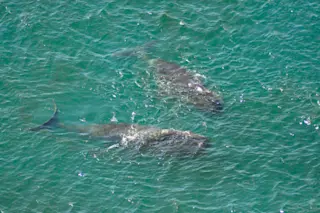Every year research stations in Antarctica launch more than 9,000 balloons, ranging in size from small weather balloons six feet in diameter to enormous, telescope-lofting gas bladders large enough to contain three jumbo jets nose to tail. As the balloons rise, the helium inside them expands and eventually bursts the balloons, or the gas escapes after the balloons release their instruments. Their plastic skins--neoprene or polyethylene--drift back to Earth, landing on the ice sheet or in the surrounding oceans. No one retrieves the tons of plastic that land each year in the sea. And that, says ecologist Gerald Eddlemon, may be bad for the blue whales, humpbacks, sperm whales, and right whales that cruise those waters.
Eddlemon, who works at Oak Ridge National Laboratory in Tennessee, wanted to know what effect such wholesale ocean dumping of plastics has on whale populations around the continent. But direct research in the stormy ...














